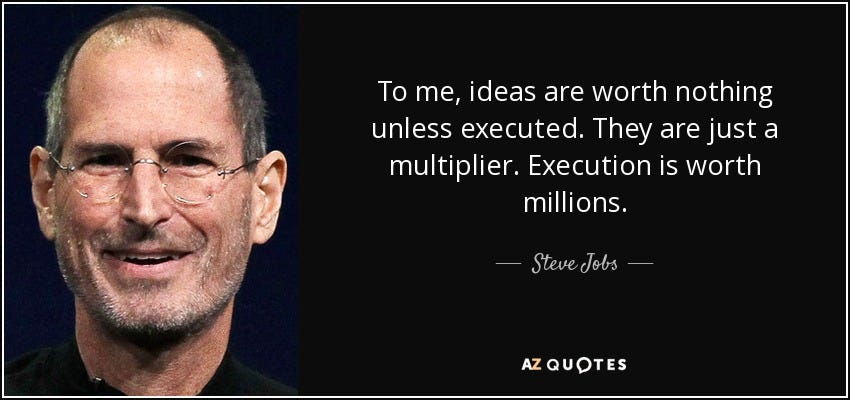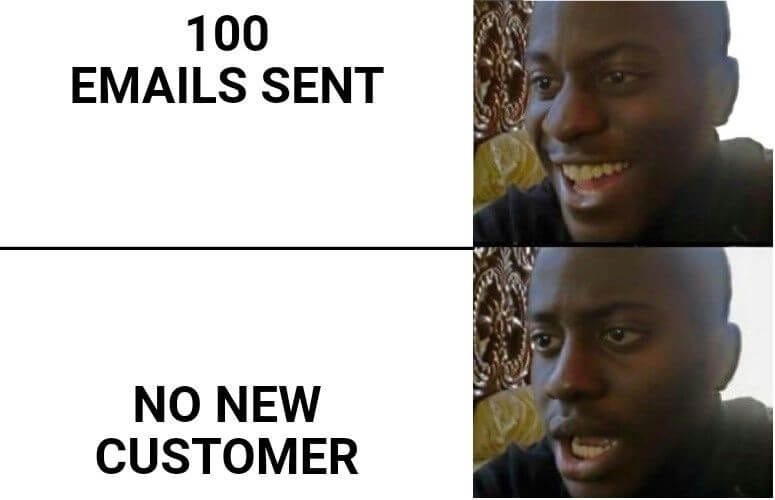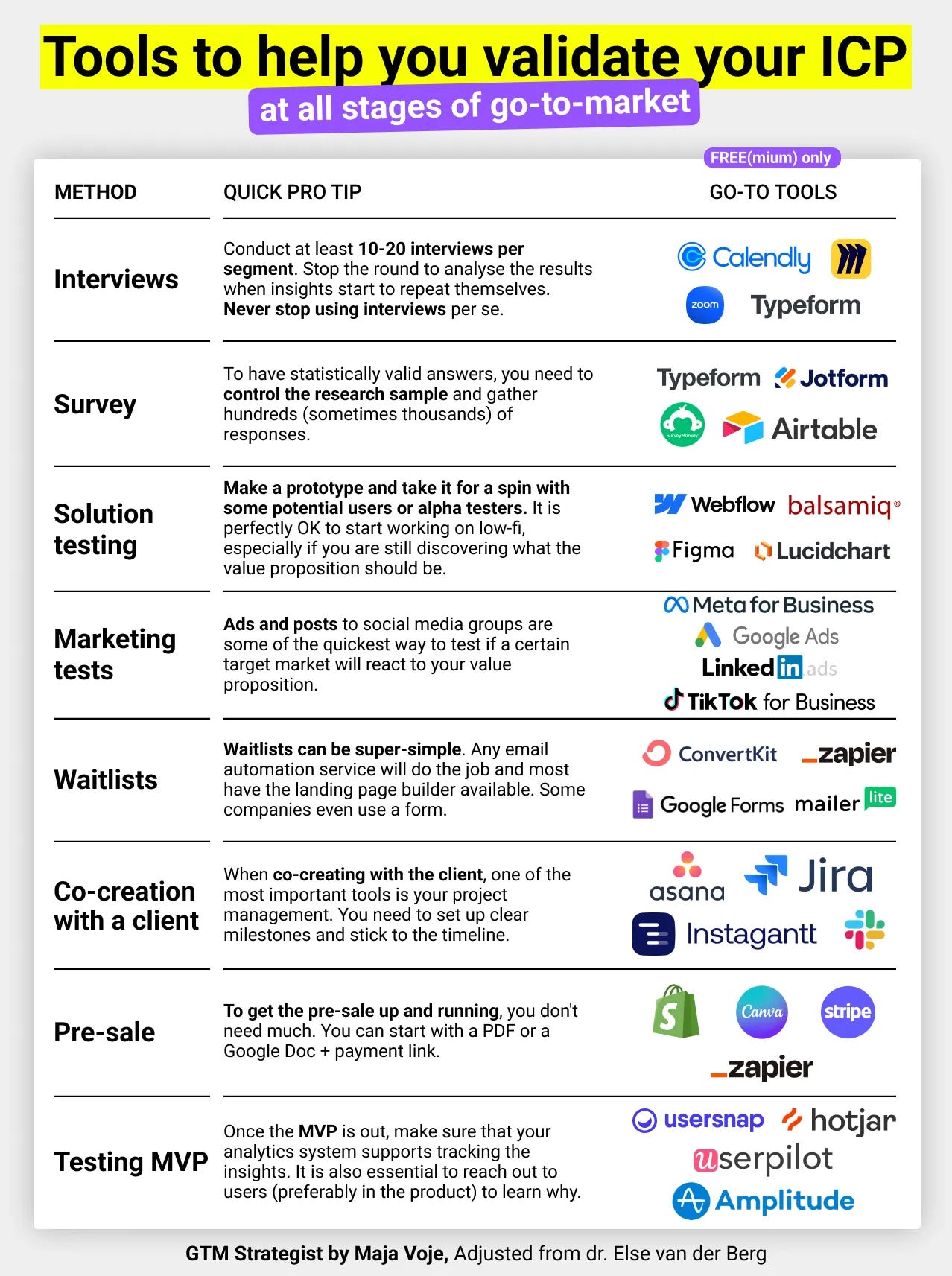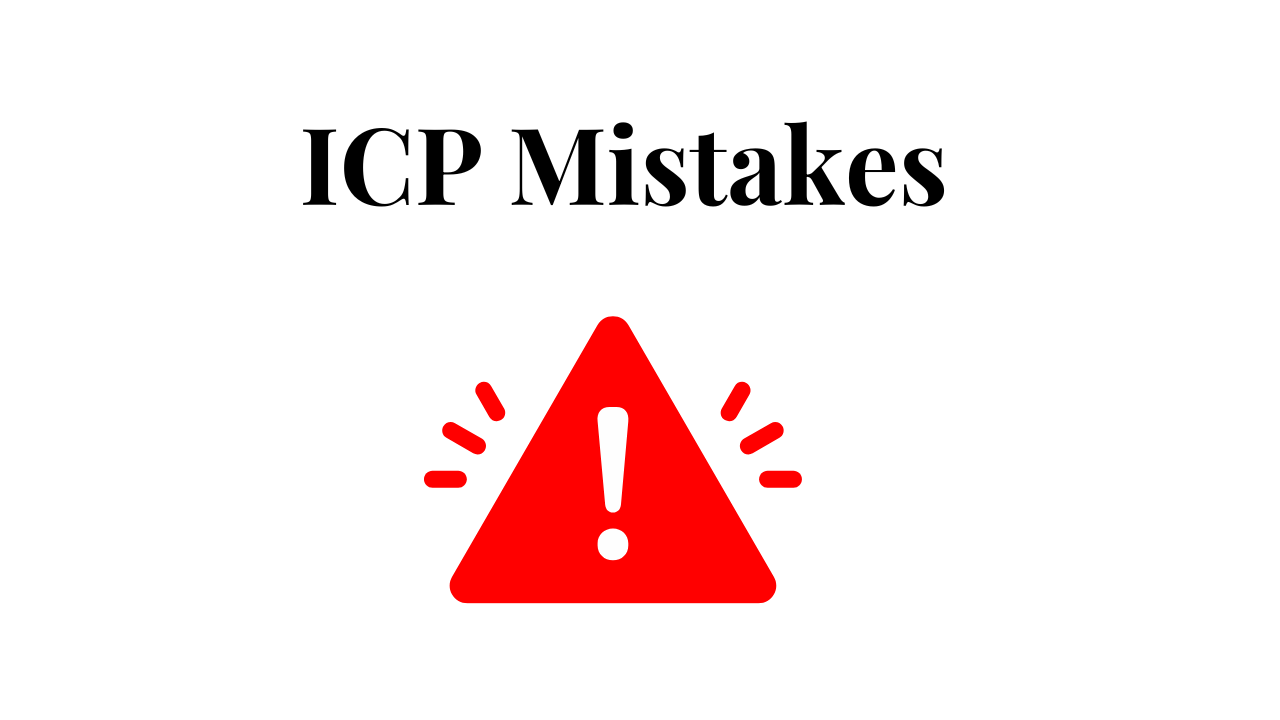How to Get Your First 100 Customers: Early Customer Acquisition Tactics
Small Business OS: How to spot, speak to, and get your first 100 customers.
"To me, ideas are worth nothing unless executed. They are just a multiplier. Execution is worth millions." - Steve Jobs
The hardest part of starting a company isn’t coming up with the idea. It’s not even building the product.
It’s getting those first 100 customers.
You believe in what you’ve built, but no one else seems to notice.
You post about it. Nothing.
You send cold emails. No replies.
Meanwhile, you see other founders somehow landing users left and right.
You’ve done your research and early validation with a target group - but how do you find the ones that will buy from you?
The truth is, your first customers are already looking for a solution like yours. The challenge isn’t convincing them to care, it’s making sure they find you before someone else.
Instead of chasing everyone, focus on the ones who need what you offer right now.
Those first 100 customers are the group that validates your business idea, loves your product/solution and become your loyal brand ambassadors. Find them where they already are: LinkedIn groups, Slack communities, Reddit, niche events. Offer value, build trust, and start conversations.
So let’s get into it and learn about how to define who they are, how to show up in the right places, and how to make it easy for them to say yes.
Table of Contents
Why Knowing Your ICP Matters
What Is an ICP?
How to Create an Effective ICP
Using Your ICP in Go-to-Market Strategies
When to Update Your ICP
How to Reverse Engineer Your ICP
Difference Between an ICP and a Buyer Persona
How to Use Your ICP to Improve Business Growth
Watch Out! Don’t Do This When Defining Your ICP
Your ICP = Your Foundation
1. Why Knowing Your ICP Matters
Imagine launching a product, telling everyone about it, and getting…crickets. No sign-ups, no interest, just silence. It’s not because your product isn’t valuable. It’s because you’re talking to the wrong people.
Your ideal customers aren’t just anyone who might be interested. They’re the ones who need your product, feel the problem you solve, and are ready to take action. That’s why defining your ICP early is so important. Without it, you waste time convincing people who were never going to buy in the first place.
A clear ICP means knowing where to focus. Instead of throwing marketing dollars into the void, you show up in the right communities, speak directly to the right people, and build trust with those most likely to buy. It also makes sales easier because when you target customers who already need a solution, your pitch feels less like selling and more like solving.
Businesses that get this right grow faster, convert more leads, and build stronger customer relationships. Your first 100 customers aren’t random. They’re part of a pattern, one you need to identify and double down on. The sooner you do, the smoother your path to traction.
2. What Is an ICP?
An ICP is a detailed description of your most valuable customers, the ones who are most likely to buy, stay, and advocate for your product. In both B2B and B2C business scenarios, an ICP helps you refine your targeting, but how it applies differs.
For a B2C business, an ICP focuses on demographics, psychographics, and behavioral traits that define the perfect individual customer. This might include factors like age, location, income level, lifestyle, or shopping habits. For example, a premium fitness brand might define its ICP as “health-conscious professionals aged 25–40 who purchase high-end athletic gear and engage with fitness influencers on Instagram.”
However, ICP is far more relevant in B2B because purchases are made at the company level. Instead of targeting individual consumers, businesses need to identify the right companies based on factors like industry, company size, budget, and buying behavior. If you sell HR software, your ICP might be “mid-sized tech companies with 100–500 employees, a growing HR team, and a need for automated hiring solutions.”
While B2C businesses often rely more on buyer personas, B2B companies depend on ICPs to structure their sales and marketing efforts, ensuring they target organizations that fit their product best.
3. How to Create an Effective ICP
A well-defined ICP ensures you focus on the right customers, the ones who need your product most and will drive long-term value. A structured approach helps refine your targeting and optimize growth.
Analyze Your Best Customers
Start with real data. Who are your highest-value customers? Look at:
Fastest conversions: Who buys with minimal friction?
Longest retention: Which customers stick around and renew?
Biggest spenders: Who generates the most revenue?
If you have no customers yet, analyze your competitors’ users, who are they targeting?
Identify Key Firmographics & Behaviors
For B2B:
➡️ Industry & business model: Who benefits most from your solution?
➡️ Company size & revenue: Are you targeting startups, mid-market, or enterprise?
➡️ Pain points & buying behavior: What’s the trigger for purchasing?
For B2C:
➡️ Demographics & spending habits: Who actively pays for similar solutions?
➡️ Channels: Where do they research and buy?
Research Where They Engage
Find them before they need you. Join:
B2B: LinkedIn groups, founder Slack channels, niche industry forums.
B2C: Reddit, Instagram, Discord, or YouTube influencers in your space.
Validate & Refine Your ICP
Your ICP should evolve as your business grows. Talk to at least 10 of your highest-retention customers and ask why they chose you, what alternatives they considered, and what made them stay. If you’re seeing churn, analyze where it’s happening, are you attracting the wrong users, or is there a mismatch in expectations?
Look at sales cycles, renewal rates, and customer feedback to spot trends. Iterate every six months based on actual data, not assumptions. The more you refine your ICP, the more efficient your marketing, sales, and retention efforts become.
A clear ICP means better leads, faster sales, and lower churn. The more focused you are, the faster you scale.
4. Using Your ICP in Go-to-Market Strategies
Defining your ICP is just the first step. The real impact comes when you apply it across your go-to-market (GTM) strategy, ensuring that every marketing campaign, sales effort, and outreach message is aligned with the right audience.
Targeted Marketing That Converts
Your ICP helps you eliminate low-ROI marketing efforts and double down on channels that actually bring in high-value customers. Instead of wasting budget on broad, low-intent audiences, build a content and ad strategy designed for buyers actively looking for a solution.
If your ICP is SaaS startups with 10-50 employees, run ads that target decision-makers (CEOs, Heads of Growth) using LinkedIn’s job title filters. Research the exact search terms your ICP is using when looking for solutions.
Optimize landing pages and blog content around those pain points. Join ICP-specific online spaces, Slack groups, Twitter communities, subreddits, and add value before selling. Answer questions, share insights, and become a recognized name.
Smarter Sales Prospecting
Your sales team should only focus on prospects that fit your ICP to increase win rates and reduce wasted effort. Use LinkedIn Sales Navigator, Apollo.io, or Crunchbase to filter companies based on ICP criteria (industry, funding stage, company size). Track buying signals, funding rounds, hiring sprees, or tech stack changes that indicate they need a solution like yours. Instead of blasting generic emails, send hyper-personalized messages that reference a company’s recent challenges or achievements.
Personalization & Messaging
The way you position your product should feel tailor-made for your ICP. When messaging aligns with a prospect’s needs, conversion rates skyrocket. Instead of one-size-fits-all messaging, create landing pages that speak directly to different ICP segments. Example: If targeting fintech startups, use case studies and testimonials from fintech companies.
Your emails and sales calls should start with the exact problems your ICP faces. Example: “Growing fintech companies struggle with compliance automation, we help solve that.” Not every high-fit prospect converts immediately. Retarget ICP-matching visitors with LinkedIn and display ads that reinforce your value proposition.
A strong ICP turns your GTM strategy from trial-and-error into a focused, scalable approach helping you attract, close, and retain the right customers.
5. When to Update Your ICP
Your ICP isn’t static but should evolve as your business grows and market conditions change. Sticking to an outdated ICP can lead to wasted effort on low-fit customers, missed opportunities, and declining conversions.
Your Best Customers Are Changing
If the customers driving the most revenue and engagement today look different from those you initially targeted, it’s a clear sign your ICP needs refinement. Check your highest retention and highest lifetime value (LTV) customers, are they in a different industry, company size, or growth stage than before? If so, adjust your targeting to attract more of them.
New Market Trends or Product Changes
Markets shift, and so should your ICP. If new regulations, emerging technologies, or economic shifts change how your industry operates, reassess whether your target customers still face the same pain points. Similarly, if you expand your product features, add new pricing tiers, or shift from SMB to enterprise, your ICP may need an overhaul.
Your Sales & Marketing Data Tells a Different Story
Declining conversion rates, longer sales cycles, or increased churn could indicate your ICP is misaligned. Are you attracting too many unqualified leads? Is your ideal customer engaging differently than before?
Analyze win-loss data, lead sources, and customer feedback to identify gaps between your targeting and actual paying customers.
Competitive Positioning & Industry Saturation
If your original ICP market is now saturated with competitors, or if you’re seeing diminishing returns from existing segments, it might be time to explore adjacent markets. Look at where your competitors are gaining traction—are they targeting a segment you’ve overlooked?
Regularly reviewing your ICP ensures you’re always targeting the right customers, keeping your growth strategy sharp and effective.
6. How to Reverse Engineer Your ICP in 3 Steps
If you’re unsure who your ideal customers are, you don’t have to guess, you can reverse engineer your ICP by analyzing existing patterns and uncovering what’s already working.
1. Start with Your Best Customers
Your most valuable customers are the ones who stay, spend, and refer others. Identify your top 20% highest-LTV customers and analyze common traits:
❓Industry & company size:
Are they SaaS, fintech, ecommerce? Startups, mid-market, or enterprise?
❓Decision-making process:
How do they evaluate and purchase solutions like yours?
❓Trigger events:
What pushed them to look for your product in the first place?
2. Analyze Sales & Retention Data
Dig into your CRM. Look at:
❓Fastest-converting customers:
Who required the least convincing?
❓Lowest churn rates:
Which customers stick the longest?
❓Biggest spenders:
Who upgrades, renews, or expands usage?
3. Conduct Customer Interviews
Numbers tell part of the story, but conversations reveal the "why." Talk to your happiest customers and ask:
Why did you choose us over competitors?
What problem were you actively trying to solve?
What would have stopped you from buying?
These insights help fine-tune your ICP by capturing the exact words and concerns your target customers have.
Test & Validate
Once you’ve identified your ICP, put it to the test. Run targeted LinkedIn ads to see which segment engages most, and adjust cold outreach messaging to match the new ICP’s language and objections. Keep a close eye on win rates, and if you see an improvement, you’re on the right track.
By reverse engineering your ICP, you focus on proven success patterns rather than assumptions. This helps you attract the right customers faster.
7. Difference Between an ICP and Buyer Persona
Understanding the distinction between an ICP and a Buyer Persona is crucial for effective marketing and sales strategies, especially in B2B contexts. It’s easy to mix up the two, but here are the main differences.
ICP: The Right Customer
An ICP is a hypothetical description of the perfect customer that would benefit significantly from your product or service and, in return, provide substantial value to your business. It focuses on the organizational characteristics that make a company an ideal fit.
Key Attributes of an ICP:
Industry and Business Model: Identifying the sectors and operational frameworks where your solution is most applicable.
Company Size: Considering factors like employee count or revenue to determine scale.
Geographic Location: Targeting specific regions or markets.
Pain Points: Understanding common challenges these companies face that your offering can address.
Technological Adoption: Assessing the tools and technologies commonly used within these organizations.
Example: A software firm might define its ICP as "mid-sized e-commerce companies in North America with annual revenues between $10M–$50M, seeking to enhance their customer service operations."
Buyer Persona: The Right Individual
A Buyer Persona is a semi-fictional representation of your ideal customer within the target company, based on market research and real data. It delves into the individual characteristics of the decision-makers or influencers who are involved in the purchasing process.
Key Attributes of a Buyer Persona:
Demographics: Age, gender, education, etc.
Job Role and Responsibilities: Specific functions and duties within the company.
Goals and Challenges: Professional objectives and obstacles they encounter.
Communication Preferences: Preferred channels and styles of interaction.
Decision-Making Power: Level of influence in purchasing decisions.
Example: In the previous ICP mentioned, a Buyer Persona could be "Operations Manager Olivia, aged 35–45, responsible for overseeing customer service teams, aiming to reduce response times, and preferring email communication."
Let’s summarize the core aspects of an ICP and Buyer Persona in the context of both B2C and B2B.
8. How to Use Your ICP to Improve Business Growth
A well-defined ICP is your business’s growth engine and not just a marketing tool. When you consistently target and serve the right customers, you shorten sales cycles, increase retention, and maximize revenue. Here’s how to use your ICP to drive sustainable growth.
Attract Higher-Quality Leads
Your ICP helps you stop chasing low-fit prospects and focus on buyers who are already looking for a solution like yours. Instead of spreading your marketing thin, invest in high-intent channels where your ideal customers are actively engaging, LinkedIn, industry-specific Slack groups, and niche communities. Use their language, pain points, and buying triggers in your messaging to increase inbound conversion rates.
Increase Sales Efficiency
Sales teams waste time on leads that were never a good fit. Your ICP acts as a filter, allowing sales to qualify and prioritize prospects faster. If a lead doesn’t match your ICP’s firmographics or behaviors, move on. Less time on the wrong customers means shorter sales cycles, higher win rates, and more predictable revenue.
Improve Customer Retention & Expansion
The right customers don’t just buy from you but stick with you, spend, and spread the good word. An ICP-driven acquisition strategy ensures you attract users who can fully adopt and benefit from your product. Happy customers renew, expand their accounts, and refer others, fueling organic growth with lower acquisition costs.
Align Product Development
Your ICP doesn’t just shape marketing and sales, it guides what you build. If your highest-value customers consistently request certain features, that’s a signal for product development. Use ICP insights to optimize pricing models, feature roadmaps, and customer success strategies, ensuring you continue to serve your most profitable users.
9. Watch Out! Don’t Do This When Defining Your ICP
A well-crafted ICP can accelerate growth, but a poorly defined one can waste time, drain resources, and stall traction. Here are the most common mistakes to avoid:
Being Too Broad or Too Narrow
If your ICP is too broad, you’ll attract low-quality leads that never convert. If it’s too narrow, you’ll limit your market and miss opportunities. A strong ICP is specific but scalable, focused enough to guide your efforts while allowing room for growth.
Relying on Assumptions Instead of Data
Guessing who your ideal customer is can lead to wasted marketing dollars and missed sales. Instead, analyze your best existing customers, look at competitors, and gather real-world insights before defining your ICP.
Confusing ICP with Buyer Personas
Your ICP defines the type of company you’re targeting, while buyer personas describe the people within those companies. Mixing the two can lead to unfocused messaging and inefficient outreach.
Not Revisiting Your ICP Regularly
Markets evolve, and so should your ICP. If your product expands or customer behavior shifts, update your profile to stay aligned with the right audience.
A well-defined ICP is an evolving strategy, not a one-time exercise. Keep refining it to ensure you’re always targeting the right customers.
10. Your ICP = Your Foundation
Getting your first 100 customers isn’t just about finding any buyers, it’s about finding the right buyers. The ones who truly need your product, who will stick around, and who will help your business grow. That’s why defining your ICP isn’t just a marketing exercise, but the very foundation for everything that follows.
When you know exactly who you’re targeting, your marketing becomes sharper, your sales process becomes smoother, and your retention skyrockets. Instead of chasing leads that won’t convert, you focus on customers who find real value in what you offer.
Your first 100 customers are out there. Now that you know how to find them, it’s time to take action, engage, connect, and build relationships that turn first-time buyers into lifelong advocates.










Useful for founders 🙌
You can build for everyone and convert no one.
You can speak broadly and be ignored locally.